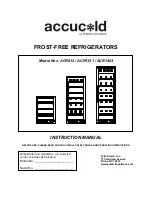
Troubleshooting table
Page EN-24
Troubleshooting table
Malfunctions can occur in all electrical appliances. This does not necessarily mean
there is a defect in the appliance. For this reason, please check the tables to see if you
can correct the malfunction.
WARNING
Risk of electric shock in case of improper repair!
Never try to repair a defective or suspected defective appliance yourself. You can put
your own and future users’ lives in danger. Only authorised specialists are allowed to
carry out this repair work.
Problem
Possible cause
Solutions, tips, explanations
Compressor off,
LED light cannot
be switched on.
No electricity to socket.
Check the socket with another appliance.
Mains plug is loose.
Check the tightness of the mains plug.
Compressor off,
LED light can be
switched on.
Desired temperature has
been reached.
Further cooling not required. When the
inside temperature rises, the compressor
automatically switches on.
Appliance cools
too quickly.
The temperature controller is
set at too high a level.
Select a lower setting (see “Setting the
temperature” on page EN-11).
The appliance
does not cool suffi-
ciently.
The temperature setting is
set too low.
Select a higher setting (see “Setting the
temperature” on page EN-11).
Door not tightly closed or
door seal is not completely
tight.
See “Checking and cleaning the door
seals” on page EN-15.
The appliance is near a heat
source.
Place insulation plate between the appli-
ances or change location.
Appliance is standing in di-
rect sunlight.
Change its location.
Minimum distances not
maintained (too short).
Ensure that minimum distances to walls
and other devices are upheld (see “Choos-
ing a suitable location” on page EN-18).
Too many beverages being
stored.
Do not exceed the maximum total volume;
see type plate.
Ambient temperature too low
or too high.
Adjust ambient temperature (see “Intended
use” on page EN-4).
Compressor seems defec-
tive.
Set the temperature to “5”. If the com-
pressor does not switch on within an hour,
please contact our service department (see
page EN-26).





































